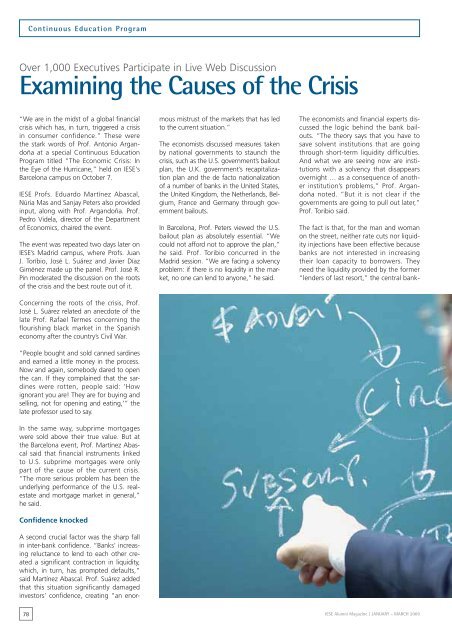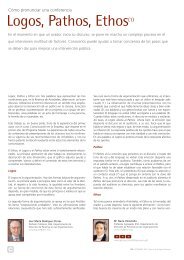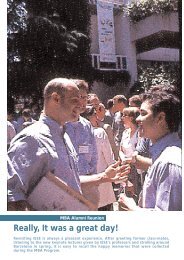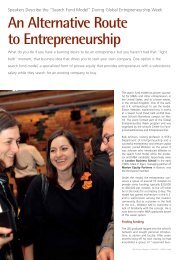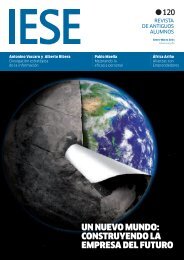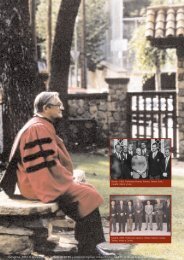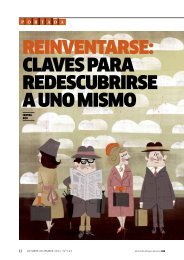Alumni Magazine - revista iese.
Alumni Magazine - revista iese.
Alumni Magazine - revista iese.
You also want an ePaper? Increase the reach of your titles
YUMPU automatically turns print PDFs into web optimized ePapers that Google loves.
Continuous Education Program<br />
Over 1,000 Executives Participate in Live Web Discussion<br />
Examining the Causes of the Crisis<br />
“We are in the midst of a global financial<br />
crisis which has, in turn, triggered a crisis<br />
in consumer confidence.” These were<br />
the stark words of Prof. Antonio Argandoña<br />
at a special Continuous Education<br />
Program titled “The Economic Crisis: In<br />
the Eye of the Hurricane,” held on IESE's<br />
Barcelona campus on October 7.<br />
IESE Profs. Eduardo Martínez Abascal,<br />
Núria Mas and Sanjay Peters also provided<br />
input, along with Prof. Argandoña. Prof.<br />
Pedro Videla, director of the Department<br />
of Economics, chaired the event.<br />
The event was repeated two days later on<br />
IESE’s Madrid campus, where Profs. Juan<br />
J. Toríbio, José L. Suárez and Javier Díaz<br />
Giménez made up the panel. Prof. José R.<br />
Pin moderated the discussion on the roots<br />
of the crisis and the best route out of it.<br />
Concerning the roots of the crisis, Prof.<br />
José L. Suárez related an anecdote of the<br />
late Prof. Rafael Termes concerning the<br />
flourishing black market in the Spanish<br />
economy after the country’s Civil War.<br />
“People bought and sold canned sardines<br />
and earned a little money in the process.<br />
Now and again, somebody dared to open<br />
the can. If they complained that the sardines<br />
were rotten, people said: ‘How<br />
ignorant you are! They are for buying and<br />
selling, not for opening and eating,’” the<br />
late professor used to say.<br />
In the same way, subprime mortgages<br />
were sold above their true value. But at<br />
the Barcelona event, Prof. Martínez Abascal<br />
said that financial instruments linked<br />
to U.S. subprime mortgages were only<br />
part of the cause of the current crisis.<br />
“The more serious problem has been the<br />
underlying performance of the U.S. realestate<br />
and mortgage market in general,”<br />
he said.<br />
Confidence knocked<br />
A second crucial factor was the sharp fall<br />
in inter-bank confidence. “Banks' increasing<br />
reluctance to lend to each other created<br />
a significant contraction in liquidity,<br />
which, in turn, has prompted defaults,”<br />
said Martínez Abascal. Prof. Suárez added<br />
that this situation significantly damaged<br />
investors’ confidence, creating “an enormous<br />
mistrust of the markets that has led<br />
to the current situation.”<br />
The economists discussed measures taken<br />
by national governments to staunch the<br />
crisis, such as the U.S. government’s bailout<br />
plan, the U.K. government’s recapitalization<br />
plan and the de facto nationalization<br />
of a number of banks in the United States,<br />
the United Kingdom, the Netherlands, Belgium,<br />
France and Germany through government<br />
bailouts.<br />
In Barcelona, Prof. Peters viewed the U.S.<br />
bailout plan as absolutely essential. “We<br />
could not afford not to approve the plan,”<br />
he said. Prof. Toribio concurred in the<br />
Madrid session. “We are facing a solvency<br />
problem: if there is no liquidity in the market,<br />
no one can lend to anyone,” he said.<br />
The economists and financial experts discussed<br />
the logic behind the bank bailouts.<br />
“The theory says that you have to<br />
save solvent institutions that are going<br />
through short-term liquidity difficulties.<br />
And what we are seeing now are institutions<br />
with a solvency that disappears<br />
overnight … as a consequence of another<br />
institution’s problems,” Prof. Argandoña<br />
noted. “But it is not clear if the<br />
governments are going to pull out later,”<br />
Prof. Toribio said.<br />
The fact is that, for the man and woman<br />
on the street, neither rate cuts nor liquidity<br />
injections have been effective because<br />
banks are not interested in increasing<br />
their loan capacity to borrowers. They<br />
need the liquidity provided by the former<br />
“lenders of last resort,” the central bank-<br />
78<br />
IESE <strong>Alumni</strong> <strong>Magazine</strong> / JANUARY - MARCH 2009


